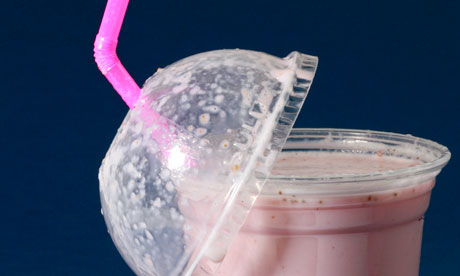
"Why are the children drinking pink milk?" asked the Finnish intern my family was hosting. As a graduate student, Nina came here last year to research American perspectives on green marketing. She accompanied me to a client site, where our task was to increase recycling in a large North Texas school district. That day, I was counting aluminum cans in the trash when Nina asked about the strawberry-flavored milk.
I looked around the cafeteria and, at first, I saw nothing unusual. The hamburgers and heaps of fries harkened back to my high school days – vintage Americana. But the pink milk gave me pause. Inspecting the label, I noted that the strawberry-flavored bottled milk contained 33g of sugar, enough high-glycemic carbohydrates for more than two meals worth of food. Empty calories multiply as students combine flavored milk with those hamburgers and fries. When I looked up from the label, I saw something I hadn't before: a cafeteria full of overweight adolescents – our future citizens and leaders.
When Nina first asked about the pink milk, I remember trying to rationalize. America is about freedom of choice. If the kids want pink milk, by golly, let them have it!
Besides, other factors beyond sugary beverages contribute to our obesity epidemic. Anyway, how could a Scandinavian possibly understand the challenges of trying to educate everyone about making healthy food choices in a free-market melting pot?
However, anti-nanny state rationalizations become foolish when we examine the real cost of defending our right to consume everything we desire. According to the Centers for Disease Control and Prevention, childhood obesity has more than tripled in the past 30 years. Today, more than one third of children and adolescents are overweight or obese. According to health economist John Cawley of Cornell University, our nation now allocates over 20% of healthcare expenditures, or $190bn per year in additional medical spending, on obesity.
Yes, the calcium and Vitamin D in milk are important, but what does it say about where America is headed when it takes four spoonfuls of sugar to make the medicine go down? Realizing that I could not justify the food selections in our public schools, I started to feel angry, helpless, and ultimately, embarrassed. Rather than impress Nina, our schools failed in a critical area: nutrition.
I contacted the cafeteria manager to find out why she served pink milk. "Because that's all the kids want to drink," she replied. The government tells schools they need to serve milk, and the food distributors are happy to oblige by selling districts milk with added sugar and artificial color. Seems the biggest losers in this system are our children.
To be fair, going above and beyond basic nutritional requirements may look like a luxury that a large, underfunded public school district can't afford. On the list of priorities, pink milk rates pretty low. As long as it complies with state and federal standards, there's little incentive to change it – except that it's harming our kids.
Pink milk raises a Red Dye 40 flag. A few months ago, the nation was outraged by the revelation that their ground beef is full of a suspect and disgusting substance we now all know as "pink slime". Now would be a good time to extend the discussion of pink slime on the plate to the pink stuff in the bottle next to it. Seeing my world through the eyes of my "Fintern" got me curious. Finland is one of the best-educated countries, and it's also one of the healthiest. At a time when America is expanding its waistline while slipping in educational rankings, could elevating nutrition in schools be a lever for societal transformation? Yes, and it's already happening.
The DC Healthy Schools Act, which passed unanimously in May 2010 and went into effect in August 2010, has been hailed model school wellness and anti-hunger legislation for America. Addressing the complex cycle of obesity and poverty, the multifaceted solution includes serving free breakfast; encouraging farm to school programs; following enhanced nutrition standards in cafeterias and vending machines; and increasing physical and environmental education. In December 2010, President Obama signed the Healthy, Hunger-Free Act of 2010 into federal law, a step toward bringing some of these benefits to impoverished school children across America.
Such programs have the capacity to move our children out of strawberry-flavored milk and into fresh strawberries, but it won't happen overnight; nor will it happen without parental support. In spite of the progress, flavored milk is still being served, including at my own kids' school. "We can't remove it from the menu until the government mandates it," an administrator from our school told me. "We'll get too much pushback from parents who fear that their kids will stop drinking milk altogether."
In serving flavored milk, our schools may be in compliance with federal regulations, but we can do better than the bare minimum, especially since the minimum is so bad for America's future. Unless and until school districts adopt more rigorous requirements, parents can support Jamie Oliver's campaign to bring back plain milk at school. We can also raise our own standards by modeling responsible consumption at home. Allowing parents to exercise responsibility has consistently been the argument for schools not getting more involved. Now it's our turn to teach.
• This article was written in association withthe Op-Ed Project

